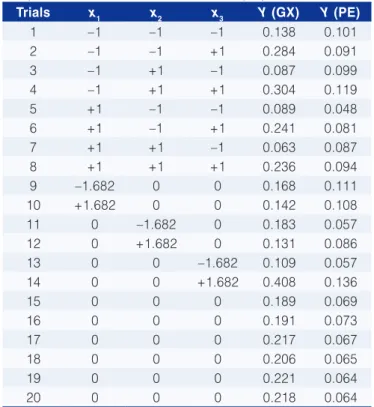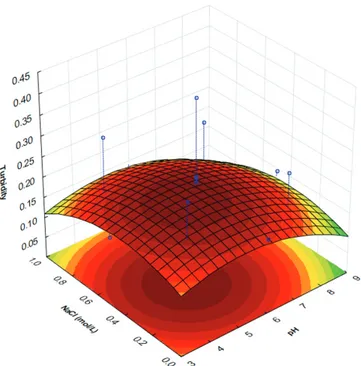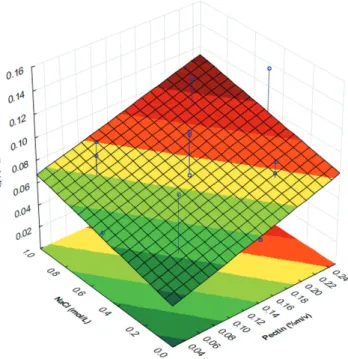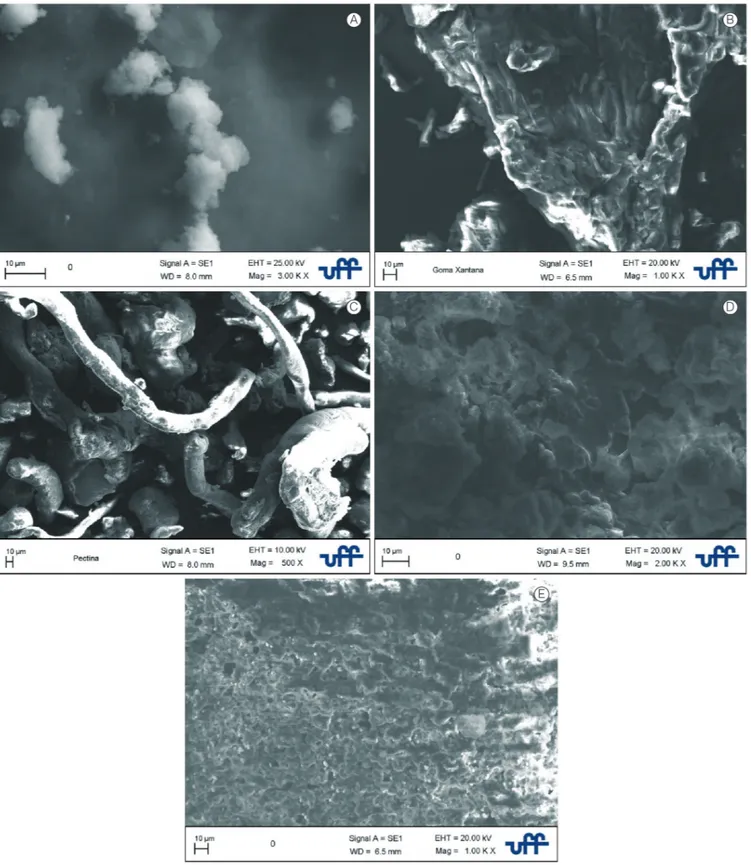Autor Correspondente | Corresponding Author Received: Apr. 04, 2014
Approved: Aug. 29, 2014
Summary
In this work, the optimization process of interpolymeric complexes formation between lactalbumin and the polysaccharides xanthan gum and pectin was studied in order to defi ne the optimum conditions for the complexes formation. For the experimental design, response surface methodology (RSM) for three independent variables was used. The optimum conditions for the complexes formation between lactalbumin and xanthan gum were: pH 6.6, NaCl concentration of 0.6 mol/L and xanthan gum concentration 0.083% w/v. And for the complexes formed between pectin and lactalbumin the conditions were: pH 6.6, NaCl concentration of 0.25 mol/L and pectin concentration of 0.113% w/v. The best fi tted model for the experimental data was that corresponding to the complex xanthan gum-lactalbumin, whose coeffi cient of determination (R²) was 0.97.
Key words: Optimization; Whey protein; Xanthan gum; Pectin.
Resumo
Neste trabalho, a otimização do processo de formação de complexos interpoliméricos entre lactoalbumina e os polissacarídeos goma xantana e pectina foi estudada a fi m de defi nir as condições ótimas para a formação dos complexos. Para o planejamento experimental foi utilizada a metodologia de superfície de resposta (MSR) para três variáveis independentes. As condições ótimas para a formação dos complexos entre lactoalbumina e goma xantana foi: pH 6,6, concentração de NaCl de 0,6 mol/L e concentração de goma xantana 0,083% m/v. E para os complexos formados entre lactoalbumina e pectina foram: pH 6,6, concentração de NaCl 0,25 mol/L e concentração de pectina, 0,113% m/v. O modelo matemático que melhor se ajustou aos dados experimentais foi o correspondente ao complexo goma xantana-lactalbumina, cujo coefi ciente de determinação (R²) foi de 0,97.
Palavras-chave: Otimização; Proteínas do soro; Goma xantana; Pectina. Autores | Authors
Virginia Coimbra ZUVANOV Universidade Federal Rural de Rio de Janeiro (UFRRJ) Programa de Pós-graduação em Ciência e
Tecnologia de Alimentos (PPGCTA) Seropédica/RJ - Brazil e-mail: vzuvanov@gmail.com Edwin Elard GARCIA-ROJAS Universidade Federal Fluminense (UFF) Laboratório de Engenharia e Tecnologia
Agroindustrial (LETA) Av. dos Trabalhadores, 420, Vila Santa
Cecilia - Volta Redonda CEP: 27255-125 Rio de Janeiro/RJ - Brazil e-mail: edwin@vm.uff.br Clitor Júnior Fernandes de
SOUZA Eliana da Silva GULÃO Luciano José Barreto PEREIRA Universidade Federal Rural de Rio de
Janeiro (UFRRJ) Programa de Pós-graduação em Ciência e
Tecnologia de Alimentos (PPGCTA) Seropédica/RJ - Brazil clitorrj@gmail.com elianagulao@yahoo.com.br lucianojbp@yahoo.com.br
lactalbumin, xanthan gum and pectin
proteins (FENNEMA, 2000; HUFFMAN and HARPER, 1999).
In the food industry, polysaccharides are known as hydrocolloids because they bind with water and ensure thickening, emulsifying and gelling properties for the systems in which they are added to (GARCIA-CRUZ, 2001). Due to their hydrophilic and hydrophobic groups, these additives have the function of thicken, stabilize, coarsen, provide viscosity, elasticity and give the desired texture to the food produced (MARUYANNA et al., 2006; TONELI et al., 2005).The main polysaccharides used are natural (carrageenan, gum arabic, guar gum, dextran, xanthan gum, alginates and pectin), and chemically modifi ed (PAGNO et al., 2009).
Thus, the objective of this study was to optimize the process of obtaining interpolymeric complexes from lactalbumin and polysaccharides xanthan gum and pectin.
2 Material and methods
Lactalbumin and the polysaccharides xanthan gum and pectin were purchased from Sigma Aldrich (St. Louis, USA). As indicated by the manufacturer, the composition of lactalbumin is 89.9% protein, 0.5% ash, 4.0% moisture, 3.8% fat and 0.3% lactose. In the experiments, analytical grade chemicals and deionized water were used.
2.1 Experimental design
Response sur face methodology (RSM) was applied to optimize the process, aiming to simultaneously evaluate the infl uence of three pre-selected variables on the formation of interpolymeric complex (MYERS and MONTGOMERY, 1995)as shown in Table 1.
The effects of pH, NaCl and polysaccharide concentration were evaluated where the dependent variable (Y) was turbidity, calculated from the transmittance reading of the supernatant. Thus, a low value of turbidity of the supernatant of systems after centrifugation represents a greater formation of interpolymeric complex. The experiment was conducted to a full factorial 23, six
repetitions of the central point and six axial points, totaling 20 experiments. The results of the experimental design were fi tted with a second-order polynomial equation by a multiple regression technique. The quadratic equation to 1 Introduction
The interaction between proteins and polysaccharides exerts direct infl uence on the macroscopic properties of foods, such as fl uidity, stability and texture, so they are widely used by the food industry. The thermodynamic compatibility is one form of interaction which may occur when proteins and polysaccharides are mixed together in an aqueous system. This interaction depends, mainly, on the electric charges of the biopolymers and the factors that infl uence the system, such as pH and ionic strength (TOLSTOGUZOV, 2003). In most cases, the complexes formed between proteins and polysaccharides are derived from electrostatic interactions with opposite charges. To further reduce the free energy of the system, these soluble complexes are aggregated until their size and surface properties lead to formation of an insoluble precipitate (SCHMITT and TURGEON, 2010).
Depending on several factors, different types of structures can be formed upon protein + polysaccharide electrostatic associative interaction: coacervates, interpolymeric complexes or co-precipitates and gels. Interpolymeric complexes are aggregates of fractal nature that phase separate as a solid precipitate. These aggregates may remain soluble or not, depending on the overall charge they bear (TURGEON and LANEUVILLE, 2009).
Turbidity and light-scattering measurements allowed to determine that protein- polysaccharide interaction begins at a critical pH, characterized by a slow increase in turbidity and related to the formation of soluble complexes. This transition occurs at the molecular level, also called primary or intrapolymeric complexation (MATTISON et al., 1995).
Whey proteins have almost all essential amino acids in excess of the recommendation of FAO / WHO(FAO, 2013)and are an important source of bioactive peptides, compounds with potential health promotion.
The lactalbumin has high water-binding properties and is heat stable. It represents 75% of the total whey proteins and 15% of total milk protein, and is constituted by α-lactalbumin, β-lactoglobulin and serum albumin. Despite the similarly named, lactalbumin should not be confused with α-lactalbumin, which is one of the serum
Table 1. Variables and levels of experimental design for the formation of interpolymeric complex.
Variables Symbol Levels
–1.682 –1 0 1 1.682
pH x1 3.0 4.2 6.0 7.8 9.0
NaCl (mol/L) x2 0 0.20 0.50 0.80 1.0
of determination R2, the result of analysis of variance, and
the level of statistical signifi cance by Fisher (F) test were used to evaluate the reliability of the polynomial model equation obtained. The level of signifi cance of regression coeffi cients was obtained by Student’s t test.
3 Results and discussion
3.1 Formation of interpolymeric complex lactalbumin - polysaccharides
In all the studied experiments, insoluble precipitated interpolymeric complexes were formed, independently of the polysaccharide used or pH, salt and polysaccharide concentration, varying only the amount of complex formed. According to Weinbreck et al. (2003), polyelectrolytes and proteins tend to form strong complexes or solid structures such as precipitates. The planning of 20 trials with their coded values and turbidity results follows in Table 2.
It was observed that at all pH values, above and below the pI of lactalbumin (around 6.0), polymer complexes were formed. According to Stone and Nickerson (2012), the electrostatic attraction between biopolymers normally occurs when they have opposite net charges, for example, in pH values lower than the pI of the proteins and in the presence of anionic polysaccharides. However, there may be interactions between highly charged polyelectrolytes at pH values higher than pI of predict the optimal point was explained as follows in
Equation 1:
= β +β +β +β +β + β + β +β + β + β + ε
2 2 0 1 1 11 1 2 2 22 2 3 3 2
33 3 12 1 2 13 1 3 23 2 3
Y X X X X X
X X X X X X X (1)
where Y is the dependent variable (turbidity), β0 is the model constant, β1, β2 and β3 are the model coeffi cients, and ε is the error. They represent the linear, quadratic and interaction effects of the variables.
2.2 Interpolymeric complexes formation
Mixtures containing lactalbumin-polysaccharide were prepared following the methodology proposed in the literature (SOUZA et al., 2013; CHOLLAKUP et al., 2010). Initially, stock solutions were prepared at 1% w/v of each polysaccharide and buffer solutions with predetermined pH and salt concentration. For the preparation of the mixture, 100 mg of lactalbumin were weighed and then added to the specifi c buffer solution and the volume of polysaccharide, according to the experimental design. The samples were stirred for 2 hours at 25 °C on an orbital shaker (TECNAL, TE 420, Brazil). To ensure the formation of interpolymeric complex, samples were kept under refrigeration (10 ± 0.5 °C) for 24 h and then centrifuged (Cientec, TC-6000, Brazil) at 5.200 g for 30 min.
2.3 Turbidimetry
After centrifugation, a 4.0 mL aliquot was taken of the supernatant for transmittance determination on a spectrophotometer (Biochrom, Libra S12, England) with a wavelength of 400 nm. According to Aberkane et al. (2010) and Chollakup et al. (2010) the turbidity (T) is defi ned by Equation 2:
= − 0 I T ln( )
I (2)
where, I0 is the intensity of incident light and I is the
intensity of light that has passed through the sample volume.
2.4 Morphological characterization
Precipitates complex were vacuum-dried at 30 °C (SPEED VAC SC 110, SAVANT INC., USA) and subsequently analyzed for their microstructure by scanning electron microscopy (ZEISS, EVO MA10, Germany). The microscope was operated in secondary electrons with accelerating voltage of 20 kV.
2.5 Statistical analysis
A software package SAS(SAS Institute Inc., 2008) was used for experimental data analysis. The coeffi cient
Table 2. Planning and experimental results (Y) of interpolymeric complexes formed with lactalbumin and polysaccharides.
Trials x1 x2 x3 Y (GX) Y (PE)
1 –1 –1 –1 0.138 0.101
2 –1 –1 +1 0.284 0.091
3 –1 +1 –1 0.087 0.099
4 –1 +1 +1 0.304 0.119
5 +1 –1 –1 0.089 0.048
6 +1 –1 +1 0.241 0.081
7 +1 +1 –1 0.063 0.087
8 +1 +1 +1 0.236 0.094
9 –1.682 0 0 0.168 0.111
10 +1.682 0 0 0.142 0.108
11 0 –1.682 0 0.183 0.057
12 0 +1.682 0 0.131 0.086
13 0 0 –1.682 0.109 0.057
14 0 0 +1.682 0.408 0.136
15 0 0 0 0.189 0.069
16 0 0 0 0.191 0.073
17 0 0 0 0.217 0.067
18 0 0 0 0.206 0.065
19 0 0 0 0.221 0.064
20 0 0 0 0.218 0.064
x1:pH ; x2:NaCl ; x3:polysaccharide; Y: turbidity; (GX) xanthan gum;
Regarding the interaction between NaCl and pectin concentration (Figure 6), it was noted that, although a broad range of parameter values have generated low turbidity values, the optimum conditions were obtained at values of salt concentration below 0.2 mol/L. In the case of salt concentration, the lower ionic strength of the system, the more interpolymeric complex was formed. According to Girard et al. (2002), who have studied proteins. This is due to the positively charged regions on
the proteins surface, called patches, and the presence of fl uctuating loads on the protein surface in pH close to their pI. Stone and Nickerson (2012) suggest that Na+ and
Cl– operate with a double layer of protection in proteins
and polysaccharides, interrupting the electrostatic attraction between them. Probably, in the experiments, the salt concentration was not high enough to prevent the formation of interpolymeric complex between lactalbumin and polysaccharides, since, according to Weinbreck et al. (2004), salt weakens the interaction, but in case of strong polyelectrolytes where liquid phase is not observed, only a precipitate, much more salt is needed to suppress the phase separation.
Analyzing Figure 1, it was observed the effect of interaction between pH and NaCl of lactalbumin-xanthan gum system. When pH values are higher than 8.0, there is a reduced response with decreasing or increasing salt concentration to extreme values. For pH values lower than 5.0, the same behavior was observed.
In Figure 2, it was found that, for any pH value within the studied range, the decrease of xanthan gum concentration led to a decrease in turbidity. Similar behavior was observed when evaluating the interaction between the concentration of xanthan gum and NaCl (Figure 3). Thus, according to Laneuville et al. (2000), the amount of xanthan gum added to the system controls the fi nal size of the complex and, in addition, the percentage of xanthan affects the overall consistency. An increase in the consistency of the system can limit the formation of polysaccharide-protein aggregates, due to the decrease of collision rate between the particles.
In this work, the values of pH and salt concentration within the studied range do not have an effect on system turbidity when the polysaccharide concentration was below 0.14% w/v. This means that these parameters are not high enough to change the structural conformation of the involved molecules. However, when only the parameters of NaCl concentration and pH were involved, it was found that both infl uence the formation of the interpolymeric complex. In this way, the conformational change caused by the ionic strength depends on the type of salt used and the degree of acetylation and pyruvilation of the sample of xanthan gum (Laneuville et al., 2000).
For pectin-lactalbumin complex, it was observed that, in the vast majority values of pH and salt concentration (Figure 4) within the studied ranges, there was a low turbidity when compared to xanthan gum-lactalbumin systems. The lowest turbidity occurred at pH close to pI of the protein β-lactoglobulin (5.3) and low salt concentrations. When analyzed the effect of interaction between pH and pectin concentration (Figure 5), the same behavior was observed.
Figure 1. Infl uence of pH and NaCl in turbidity of lactalbumin-xanthan gum system.
β-lactoglobulin and pectin with high methoxylation was not strong enough to offset the destabilizing effect caused by sodium chloride. In this work, the higher salt concentration within the studied range was not high enough to break the electrostatic bonds and prevent the formation of interpolymeric complex.
the infl uence of salt concentration on the formation of complexes between β-lactoglobulin and of high and low methoxyl pectins, destabilization caused by sodium chloride demonstrates the presence of electrostatic interactions between polysaccharide and protein. The authors found that the electrostatic interaction between Figure 3. Infl uence of NaCl and xanthan gum in turbidity of lactalbumin-xanthan gum system.
Figure 4. Infl uence of NaCl and pH in turbidity of lactalbumin-pectin system.
Figure 5. Infl uence of pH and Pectin in turbidity of lactalbumin-pectin system.
Figure 7. SEM photomicrographs of (A) Lactalbumin, (B) Xanthan Gum, (C) Pectin, (D) Lactalbumin-xanthan gum interpolymeric complex and (E) Lactalbumin-pectin interpolymeric complex.
3.2 Optimization of interpolymeric complex formation
The maximum or minimum points of the method, as described by Myers and Montgomery (1995), were
used to optimize the extraction process. It was found that the mathematical model of complex lactalbumin-xanthan gum was the best fi t to the experimental data, due to its high coeffi cient of determination R2 equal to 0.97. In
Acknowledgements
The authors thank to CNPq (Conselho Nacional de Desenvolvimento Científi co) and FAPERJ (Fundação Carlos Chagas Filho de Amparo à Pesquisa do Estado do Rio de Janeiro).
References
ABERKANE, L.; JASNIEWSKI, J.; GAIANI, C.; SCHER, J.; SANCHEZ, C. Thermodynamic Characterization of Acacia Gum-β-Lactoglobulin Complex Coacervation. Langmuir, Washington, v. 26, n. 15, p. 12523-12533, 2010. PMid:20586462. http://dx.doi.org/10.1021/la100705d
CHOLLAKUP, R.; SMITTHIPONG, W.; EISENBACH, C. D.; TIRREL, M. Phase Behavior and Coacervation of Aqueous Poly(acrylic acid)-Poly(allymine) Solutions. Macromolecules, Washington, v. 43, n. 5, p. 2518-2528, 2010. http://dx.doi. org/10.1021/ma902144k
FENNEMA, O. R. Química de los Alimentos. 2. ed. Zaragoza: Acribia, 2000. 1258 p.
FOOD AND AGRICULTURE ORGANIZATION OF UNITED NATIONS - FAO. Dietary Protein Quality Evaluation in Human
Nutrition. Rome: FAO, 2013. (FAO Food and Nutrition Paper 92). Disponível em: <http://www.fao.org/ag/humannutrition/35978-02317b979a686a57aa4593304ffc17f06.pdf>.
GARCIA-CRUZ, C. H. Uso de Hidrocolóides em alImentos: Revisão. Higiene Alimentar, São Paulo, v. 15, n. 87, p. 19-29, 2001.
GIRARD, M.; TURGEON, S. L.; GAUTHIER, S. F. Interbiopolymer Complexing Between β-Lactoglobulin and Low- and High-methylated Pectin Measured by Potentiometric Titration and Ultrafiltration. Food Hydrocolloids, Oxford, v. 16, n. 6, p. 585-591, 2002. http://dx.doi.org/10.1016/S0268-005X(02)00020-6
HUFFMAN, L. M.; HARPER, W. J. Maximizing the Value of Milk Through Separation Technologies. Journal of Dairy Science, Champaign, v. 82, n. 10, p. 2238-2244, 1999. http://dx.doi. org/10.3168/jds.S0022-0302(99)75471-8
LANEUVILLE, S. I.; PAQUIN, P.; TURGEON, S. L. Effect of Preparation Conditions on the Characteristics of Whey Protein-xanthan Gum Complexes. Food Hydrocolloids, Oxford, v. 14, n. 4, p. 305-314, 2000. http://dx.doi.org/10.1016/S0268-005X(00)00003-5
MARUYANNA, L. Y.; CARDARELLI, H. R.; BURITI, F. C. L.; SAAD, S. M. I. Textura Instrumental de Queijo Petit-suisse Potencialmente Probiótico: Influência de Diferentes Combinações de Gomas. Food Science and Technology, London, v. 26, n. 2, p. 386-393, 2006.
MATTISON, K. W.; BRITTAIN, I. J.; DUBIN, P. L. Protein-polyelectrolyte Phase Boundaries. Biotechnology Progress, Hoboken, v. 11, n. 6, p. 632-637, 1995. http://dx.doi.org/10.1021/ bp00036a005
complex formation (Equation 3) and lactalbumin-pectin formation (Equation 4), a second-order mathematical model (Pr<0.05) was obtained.
= − + ⋅ + ⋅ + ⋅ − ⋅ − ⋅ ⋅ − ⋅ + ⋅
1 1 2 3
2 2 2
1 1 3 2 3
0.1411 0.0713 0.8119 0.0053
0.0062 0.0003 0.2176 0.0003
Y x x x
x x x x x (3)
= − ⋅ + ⋅ + ⋅ + ⋅
2 1 2
2
3 1
0.2050 0.0534 0.0309
0.0019 0.0041
Y x x
x x (4)
The minimization of the response variable turbidity was studied to obtain the optimum process conditions of interpolymeric complexes formation obtained from lactalbumin-xanthan gum and lactalbumin-pectin. For the xanthan gum, pH was 6.6, salt concentration was 0.6 mol/L and polysaccharide concentration, 0.083% w/v. The values for the pectin were pH 6.6, salt concentration of 0.25 mol/L and polysaccharide concentration, 0.113 % w/v.
3.3 Morphological characterization
Using the optimal conditions for the preparation of interpolymeric complexes, the SEM images of these structures are shown in Figure 7. Figure 7A shows the structure of lactalbumin characterized by unequal agglomerates. This is probably due to the fact that lactalbumin has suffered heat treatment during the obtaining process, which changed its native structure to the denatured form. Figures 7B and 7C show the structures of xanthan and pectin isolates, respectively. It is also possible to visualize the formation of the interpolymeric complex between lactalbumin and polysaccharides xanthan gum and pectin (Figures 7D e 7E). These complexes have specific morphological characteristics and are different when compared to the initial structures.
4 Conclusions
Oxford, v. 27, n. 2, p. 271-277, 2012. http://dx.doi.org/10.1016/j. foodhyd.2011.08.006
TOLSTOGUZOV, V. B. Thermodynamic Considerations on Polysaccharide Functions. Polysaccharides Came First.
Carbohydrate Polymers, Norwich, v. 54, n. 3, p. 371-380, 2003. http://dx.doi.org/10.1016/S0144-8617(03)00210-8
TONELI, J. T. C. L.; MURR, F. E. X.; PARK, K. Estudo da Reologia de Polissacarídeos Utilizados na Indústria de Alimentos. Revista Brasileira de Produtos Agroindustriais, Campina Grande, v. 7, n. 2, p. 181-204, 2005.
TURGEON, S. L.; LANEUVILLE, S. I. Protein + Polysaccharide Coacervates and Complexes: from Scientifi c Background to Their Application as functional ingredients in food products. In: KASAPIS, S.; NORTON, I. T.; UBBINK, J. B. Modern Biopolymer Science. San Diego: Elsevier, 2009. p. 327-363. cap. 11.
WEINBRECK, F.; VRIES, R.; SCHROOYEN, P.; KRUIF, C. G. Complex coacervation of whey proteins and gum arabic.
Biomacromolecules, Washington, v. 4, n. 2, p. 293-303, 2003. PMid:12625724. http://dx.doi.org/10.1021/bm025667n
WEINBRECK, F.; NIEUWENHUIJSE, H.; ROBINJN, G. W.; KRUIF, C. G. Complexation of whey proteins with carrageenan. Journal of Agricultural and Food Chemistry, Davis, v. 52, n. 11, p. 3550-3555, 2004.
MYERS, R. H.; MONTGOMERY, D. C. Response Surface
Methodology: Process and Product Optimization Using Designed Experiments. New York: John Wiley & Sons, 1995. 1450 p.
PAGNO, C. H.; BALDASSO, C.; TESSARO, I. C.; FLORES, S. H.; JONG, E. V. Obtenção de Concentrados Protéicos de Soro de Leite e Caracterização de suas Propriedades Funcionais e Tecnológicas. Alimentos e Nutrição, Araraquara, v. 20, n. 2, p. 231-239, 2009.
SAS INSTITUTE INC. Sas/Stat® 9.2: User’s Guide. Cary: SAS Institute Inc., 2008.
SCHMITT, C.; TURGEON, S. L. Protein/polysaccharide Complexes and Coacervates in Food Systems. Advances in
Colloid and Interface Science, Philadelphia, v. 167, n. 1-2, p. 63-70, 2010. PMid:21056401. http://dx.doi.org/10.1016/j. cis.2010.10.001
SOUZA, C. J. F.; ROJAS, E. E. G.; MELO, N. R.; GASPAR, A.; LINS, J. F. C. Complex Coacervates Obtained from Interaction Egg Yolk Lipoprotein and Polysaccharides. Food Hydrocolloids, Oxford, v. 30, n. 1, p. 350-355, 2013.




